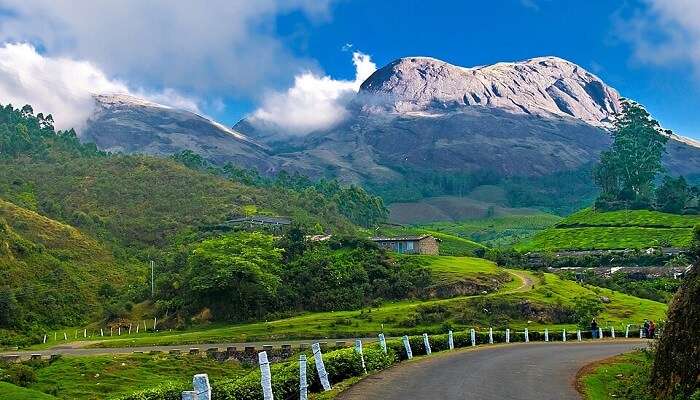Kailasanatha Temple And Its Divine Charm: A Spiritual Journey
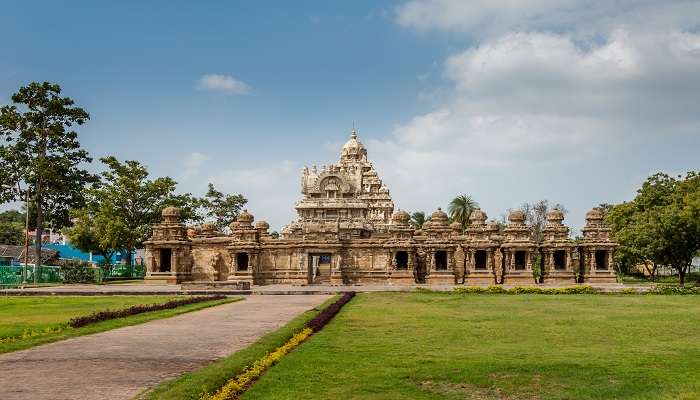
India is full of temples that can act as a ride to ancient times. Kailasanatha temple is one such timeless marvel that helps us understand the architectural brilliance of our ancestry. Nestled in the heart of Tamil Nadu, this temple showcases the union of history, religion and architecture altogether. So get ready with your reading glasses as we travel back in time and explore the best things to see or do at this ancient venue. In this guide, we are gonna unlock all the facts about Kailasanatha Temple in Kanchipuram.
Experiencing the Grandeur of Kailasanatha Temple – A Travel Guide
Kailasanatha Temple, being one of the highest ancient monuments in India, is something more than just a building. The temple is regarded as a famous cave temple and there are plenty of mysterious stories revolving around it. Join us as we explore it all in this blog:
1. Wonder At The Exterior Of Kailasanatha Temple
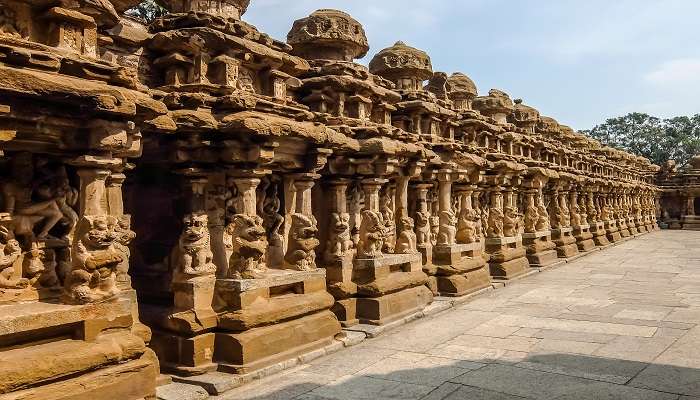
The temple, at first glance, will take you by surprise. It is one of India’s greatest monuments. The temple is carved out of solid rock. It would be an understatement to suggest that the assignment required boldness.
It is believed that King Krishna I constructed this amazing temple in AD 760 to symbolise Mt Kailasa (Kailash), Lord Shiva’s Himalayan residence. Before the temple’s amazing sculptural adornment could be added, 200,000 tonnes of rock had to be removed by hammer and chisel during the excavation of three enormous trenches into the sheer cliff face.
Things to do: Sightseeing, photoshoot
Duration: 1 – 2 hours
Must Read: Places to See in Kanchipuram
2. Explore The Interiors Of The Kailasanatha Temple
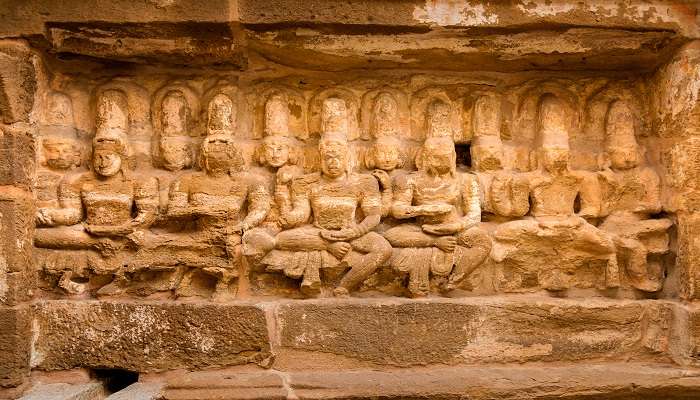
Kailasa is an engineering marvel that was designed with no room for error. Its area covers twice the space of the Parthenon in Athens while being half as high. Modern architects can surely take a few cues from this.
Several finely carved panels that show episodes from the Ramayana, Mahabharata and Krishna’s travels can be found inside the temple. The enormous monolithic pillars that flank the entrance on either side of the courtyard and the southeastern gallery, which features ten enormous and magnificent panels showing Lord Vishnu’s various avatars (incarnations of deities), are also noteworthy.
Things to do: Photoshoot, guided tours
Duration: 2-3 hours
3. Hike To Get A Bird’s Eye View Of The Temple
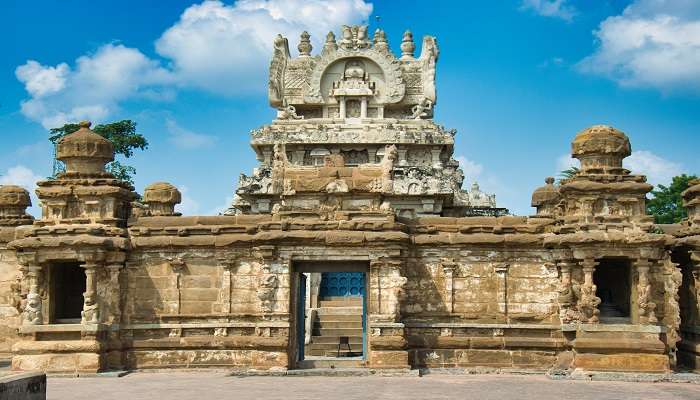
As soon as you have finished exploring the main enclosure, you should avoid the crowds of day-trippers. Instead, investigate the temple’s many damp, bat urine-soaked recesses, which have a large number of sculptures that have been overlooked otherwise.
After that, you should take the more sturdy path that leads up to the south of the complex (beyond the scaffolding), which will take you to the upper edge of the ‘cave’. From there, you will be able to obtain a bird’s-eye perspective of the entire temple complex.
Things to do: Hike, travel
Duration: 1-2 hours
Suggested Read: Temples of Chennai
4. Marvel At The Outstanding Architecture
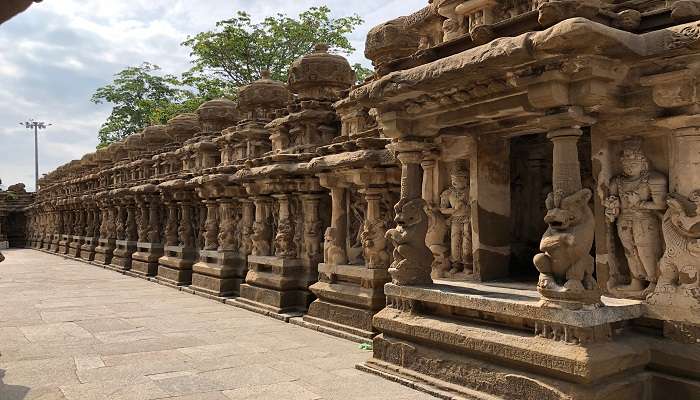
The abundance of depictions of upright lions jutting out in various directions is what makes sculptures stand out at Kailasanatha Temple. This location features two statues of Lord Shiva, both of whom are shown grasping an alapini veena, a stringed instrument.
The veenas found in the aforementioned sculptures and the veenas of today differ greatly. Beautiful sculptures of Mathahvialasa Prakshanam are also present. The Pallava King Rajasimhavarman declares his devotion to Shaivism in one of the earliest stone inscriptions found in the temple, which lists the twenty-eight Saivagamas. The interior walls’ murals are in good condition.
Things to do: Explore the interiors, sightseeing
Duration: 2 hours
5. Travel Back In Time With The History Of Kailasanatha Temple

The Pallava dynasty, whose capital city was Kanchipuram (also called “Kanchi” or “Lord Shiva Vishnu Kanchi”), is credited for the construction of the Kailasanatha Temple in Kanchipuram. Kanchipuram is one of the seven holy cities in Hinduism. Following the Pallavas’ territorial expansion to the north, west and south inside the Tamil, Andhra and Kannada empires under Emperor Narasimhavarman I, the rulers began to expand Kanchipuram, their capital city.
The temple was their effort to do so. They constructed numerous incredibly magnificent temples here, still alive and intact. One of the two exceptional examples of temple building from the 640–730 CE period is the Kailasanathar Temple, also called the Vaikunta Perumal Temple and the Tiru Parameswara Vinnagaram. Kailasanathar Temple built by around 700 AD and its reconstruction occurred in the 8th century.
Things to do: Understand the historical significance, take a guided tour of the history of the temple
Duration: 1-2 hours
Suggested Read: Temples In India
6. Immerse In The Spiritual Essence Of Lord Shiva
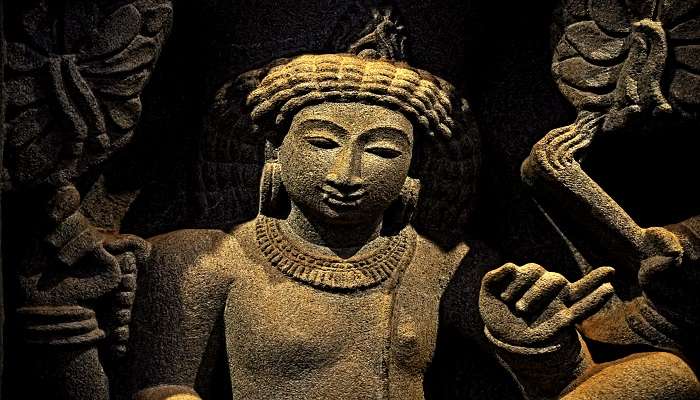
The temple has tons of sculptures, depicting hundreds of forms of Lord Shiva. A sixteen-sided Lord Shiva Lingam made of black granite and deified in the sanctum sanctorum may be found at the main temple. The padabhanda adhisthana, or main pedestal, is located inside the main shrine’s walls and features exquisitely carved statues of gods, including a sculpted Nandi standing guard a short distance away. Numerous images of deities are carved on the outer walls of the main shrine on each face.
Lord Shiva is shown in the sculpture as Umamaheshavara (Lord Shiva with his spouse Parvati) on the south-facing wall. Lingodbhava (Lord Shiva emerging as a blazing pillar or linga) is depicted alongside Brahma and Vishnu, with flying amaras on the lower level. Lord Shiva is also represented by sculptures in the west-facing hall in the forms of Sandhya and Urdhava Tandavamurti. Images of Brahma, Vishnu, Nandi and Parvati round out the ensemble, along with ganas in dancing stances.
Things to do: Sightseeing, photoshoot
Duration: 1-2 hours
7. Walk On The Circumambulatory Passage
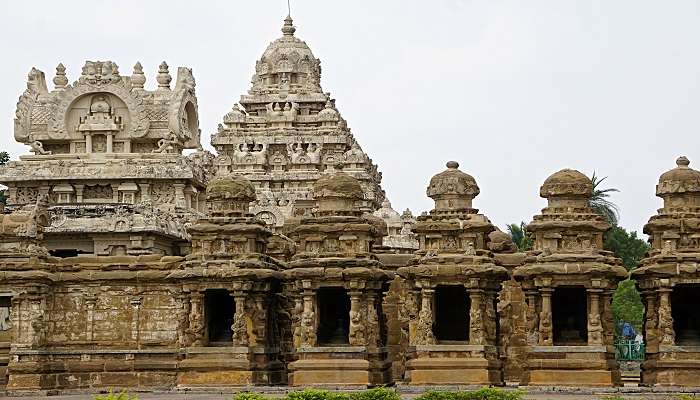
There is a symbolic circumambulatory pathway along the wall of the compound of the Kailasanathar Temple. Devotees must crawl through a small entrance passage in order to complete the circumambulation. The passage is accessed by climbing seven steps. Going through the small opening represents moving through life. Following the circumambulation, one exits through a pit or another small opening that represents death, titled as the Gate of Death.
It is said that walking around the numerous deities will bring about the same blessings as going to paradise. Crawling and emerging from the passage after completing circumambulation symbolises emerging from one’s mother’s womb and clarifies Hindus’ belief in rebirth. The exit is therefore known as the Gate of Birth. Another myth holds that one achieves Moksha and breaks free from the cycle of rebirth by completing this circumambulatory route.
Things to do: Walk, take guided tours
Duration: 1-2 hours
Further Read: Kapaleeshwarar Temple
Hope you enjoyed reading this Kailasanatha temple travel guide. However, the words may not describe the actual beauty of this place. It’s a spot that needs to be visited to experience it all. So don’t wait anymore, plan your trip to Tamil Nadu and enjoy a memorable touring experience with your loved ones. You’ll be amazed by the spiritual power of the temple and experience calm like never before.
For our editorial codes of conduct and copyright disclaimer, please click here.
Cover Image Source: Shutterstock
Frequently Asked Questions About Kailasanatha Temple
What makes Kailasanatha Temple so special and popular?
While there is so much to list, the temple’s form of being a cave temple makes it the most popular and unique. Due to its size, architecture and sculptural theme all across the walls, it’s regarded as one of the most beautiful cave temples in the world.
Who laid the foundation of the Kailasanatha Temple?
The Kailasanatha Temple built by Rajasimha Pallaveswaram, also known as Narasimhavarman II, is a true marvel. Rajasimha was the one who started the initial phase of building the temple. Later, the temple’s main parts such as the front phase and gopuram were completed by Mahendravarman III, son of Rajasimha Pallaveswaram.
What is the most interesting story related to Kailasanatha Temple?
While there are plenty of legends and facts about Kailasanatha Temple, one that tells about a weapon kept in the temple is quite interesting. It is believed that the weapon that helped build this temple is kept in a cave below. Some people even go to the extent of saying that such modern architecture during ancient times could only be made possible by aliens.
Did Pallavas construct the Kailasanatha Temple?
Yes. The Kailasanatha Temple was constructed by Narasimhavarman II, who belonged to the Pallava Dynasty. The ruler also constructed the famous Shore Temple at Mahabalipuram.
How old is the Kailasanatha Temple?
The Kailasanatha Temple was built in 773Ad. Hence, as of now, it's more than 1000 years old. Its precise age today is 1251 years.
People Also Read:
Airavatesvara Temple Bhojeshwar Temple Poornathrayeesa Temple

Get ready to wander the world through amazing visual tours that we provide via our blogs and stories. As a content writer, I love sharing incredible travel experiences that inspire readers to plan their own adventures and create unforgettable memories. From planning to execution, everything has already been served in these amusing tales. Let’s explore the world together, one destination at a time!




